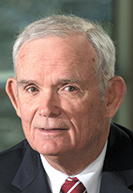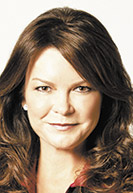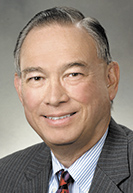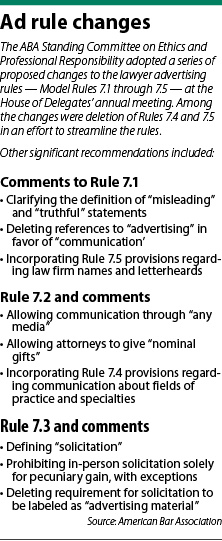Subscriber Benefit
As a subscriber you can listen to articles at work, in the car, or while you work out. Subscribe NowAmong the resolutions that came before the American Bar Association House of Delegates during its annual meeting this month was one that could significantly change the way attorneys conduct their business: Resolution 101 to amend the attorney advertising rules.
The proposed amendments to ABA Model Rules 7.1 through 7.5 come after nearly five years of studies, meetings, comments and drafts, all aimed at streamlining the advertising rules and bringing them in line with modern technology and competitive practices. The Association of Professional Responsibility Lawyers began studying the rules in 2013, and since then proposed revisions have been presented to the ABA and its members multiple times.
Resolution 101 was approved by the House of Delegates on Monday. Whether the resolution leads to any major changes in sanctioned attorney advertising conduct, Hoosier attorneys say the national conversation about the advertising rules will likely have a ripple effect that spurs similar review of state-level rules.
 Mulvaney
MulvaneyAn access issue
Outgoing APRL president and Washington, D.C., attorney George Clark said APRL’s review of Model Rules 7.1 through 7.5 came after the realization that the rules “just don’t serve any function.” Describing the problem as an access to justice issue, Clark said the restrictions in place in the model and state-level rules can prevent clients from learning about available legal services when they need a lawyer.
Clark also said state-level variations from the model advertising rules are by far the most significant variations from any ABA model rule. For example, Indiana Rules of Professional Conduct 7.1 through 7.5 share many similarities with the model rules, but they also include provisions that make them more restrictive, said Karl Mulvaney, a Bingham Greenebaum Doll partner who has served on an Indiana State Bar Association lawyer advertising task force.
 Metzel
MetzelSimilarly, ISBA President Andi Metzel said she has seen billboards advertising legal services in Illinois and Pennsylvania that take a different tone than what would be permissible in Indiana. Those differences, Clark said, pose a hurdle to attorneys who practice and advertise in multiple jurisdictions.
Finally, Clark said the model rules don’t account for advances such as social media that have changed the nature of how attorneys reach their clients.
“They should at least be able to tell people, ‘You have a problem, and we could help you,’” Clark said. “That’s providing a service to people, and that’s the important goal.”
What’s different?
A large portion of the amendments to the model rules are stylistic rather than substantive. For example, Mulvaney said the resolution recommended deleting Rules 7.4 and 7.5, but incorporated their content into Rules 7.1-7.3. The resolution also called for the elimination of the word “advertising” in favor of “communication” to represent the breadth of the rules and clarified that communication is permissible through “any media.”
Among the resolution’s significant substantive changes is an amendment removing Rule 7.3’s requirement that all lawyer solicitation be labeled with the words “Advertising Material.” Indiana incorporated that requirement into its version of Rule 7.3 and added a provision requiring attorneys to file all of their advertising materials with the Indiana Supreme Court Disciplinary Commission.
That requirement was originally drafted in the context of mailed solicitations, but it has extended to platforms such as Facebook and Twitter in the digital age, Clark said. However, according to a summary of the proposed amendments — which were submitted to the House of Delegates by the ABA Standing Committee on Ethics and Professional Responsibility — an APRL study showed no evidence of that disclaimer protecting customers because most customers have grown accustomed to receiving solicitation letters.
 Witte
WitteResolution 101 also called for an amendment to Rule 7.2 that would allow attorneys to give “nominal gifts that are neither intended nor reasonably expected to be a form of compensation for recommending a lawyer’s services.” That change is significant because it is common practice for attorneys to give gifts around the holidays, said G. Michael Witte, executive director of the disciplinary commission. Those offerings are generally small goodwill gifts, Witte said, and not large presents intended to secure future client referrals.
Metzel also pointed to an amendment to Rule 7.3 that specifically defines client “solicitation” and prohibits in-person solicitation done solely for pecuniary gain, with a few exceptions.
That change would be significant for personal injury attorneys, Metzel said, pointing to the example of a potential client receiving dozens of solicitation mailers in the wake of a car accident. But the amendment could also impact other practice areas, she said, such as family or criminal law.
“If you get arrested, can you get direct solicitation from criminal lawyers?” Metzel said. “The list goes on and on, and those kinds of targeted solicitations are pretty critical to the manner in which we practice.”
 Local impact
Local impact
In Indiana, advertising-related complaints aren’t common, Witte said, and they almost never come from clients. The people who do file complaints, Witte said, are lawyers complaining about other lawyers.
Even so, changes to the ABA Model Rules are bound to spur some action in the Hoosier state. Mulvaney said recommendations for changes to Indiana’s advertising rules have already been made, but state judicial leaders have refrained from taking any action until the ABA House of Delegates weighed in.
One recommendation Mulvaney has made is to add some leniency to the commentary to Indiana Rule 7.1. Unlike the model rule, the Hoosier rules lists 10 types of lawyer communication that would be a violation of 7.1, including the use of “statistical data or other information based on past performance or an express or implied prediction of future success.”
That restriction means Hoosier attorneys can’t advertise data about big wins or their percentage of client victories, Mulvaney said, an issue that came up in a 2014 disciplinary case he defended, In the Matter of: Anonymous, 45S00-1301-DI-33. The recommendation was to allow attorneys to post information about their success, but with a disclaimer that client results may vary.
“That would be sufficient to probably get you to safe harbor,” Mulvaney said.
The Supreme Court has not yet given any guidance on that or other proposed changes to Indiana’s advertising rules, but Metzel said the ISBA has been gathering information about the implications of any rule amendments, just in case.
In addition to changes to the ABA Model Rules on lawyer advertising, Metzel said this year’s ISBA House of Delegates meeting will include a panel discussion about the changes and whether similar changes would be right for Indiana. The idea, she said, is to get Hoosier attorneys thinking about the advertising rules so that they can provide feedback to the Supreme Court, should it seek input on possible advertising changes.
“We want to get people talking about it before a rule is made in Indiana,” Metzel said.
“It’s unfair to the courts if they seek comments, but people just complain after the fact. We want to encourage people to pay attention to any proposed rule changes in Indiana.”
Check theindianalawyer.com for updates on changes made to Model Rules 7.1 through 7.5 during the ABA Annual Meeting this month.•
Please enable JavaScript to view this content.
